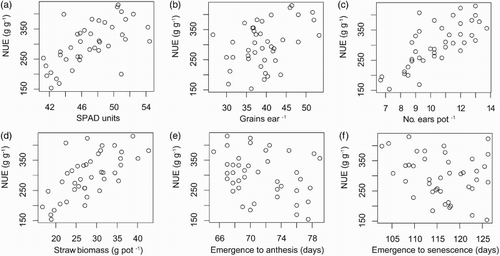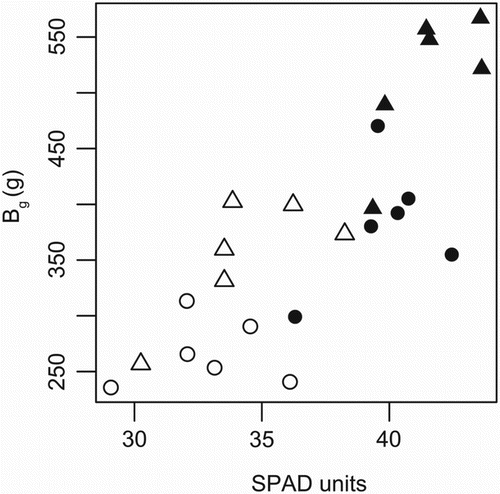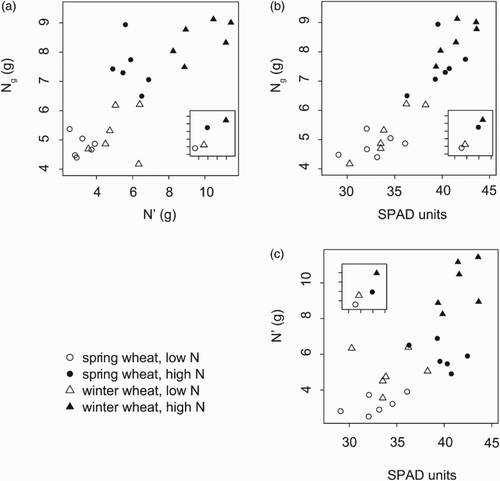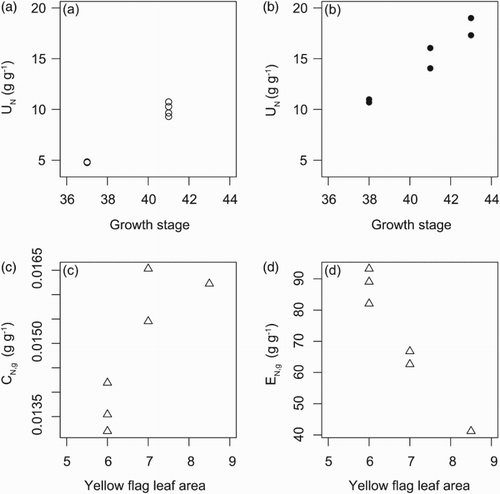Figures & data
Table 1. Definitions of NUE components according to Weih et al. (Citation2011, Citation2014).
Table 2. Varieties of wheat used in the climate chamber experiment.
Table 3. Monthly climate data for the duration of the field experiment, measured at Ultuna meteorological station about 8 km from the experimental site.
Figure 1. Plot of traits found to be important for nitrogen use efficiency (NUE) in the climate chamber experiment with 41 varieties of spring wheat, based on partial least squares (PLS) analysis. Circles represent the mean of four replicates. These important traits are (a) SPAD of the uppermost leaf at stem elongation (NUE = −307.0 + 12.9 × SPAD, R2 = .40, p < .0001); (b) number of grains per ear (NUE = 112.1 + 4.8 × grains, R2 = .16, p = .01); (c) number of ears per pot (NUE = 2.4 + 28.7 × ears, R2 = .55, p < .0001); (d) straw biomass (Bst) (NUE = 86.2 + 7.6 × Bst, R2 = .43, p < .0001); (e) days from emergence to anthesis (NUE = 705.0–5.7 × days, R2 = .09, p = .052) and (f) days from emergence to senescence of the flag leaf (NUE = 635.5–2.9 × days, R2 = .07, p = .10).

Table 4. Statistics derived from a partial least squares (PLS) analysis with NUE as the dependent variable, with one extracted factor.
Table 5. Results from ANOVA of several variables collected in a field experiment, showing F and p-values for the fixed effects.
Table 6. Pearson correlations between NUE or UN and aboveground biomass of seedlings of six winter wheat varieties in a field experiment.
Figure 2. Plot of SPAD against grain biomass (Bg) in a field experiment with spring and winter wheat varieties and two N treatments. SPAD refers to measurements taken on 2 July (winter varieties) and 9 July (spring varieties), that is, just after the major growth period, on 30 flag leaves per plot. Circles represent spring wheat and triangles winter wheat, open symbols represent the LN treatment and filled symbols the HN treatment. The equation for the relationship between the variables is Bg = −340 + 19xSPAD, and R2 = .65.

Figure 3. (a) Plot of total grain N (Ng) against mean N during the major growth period (N′) (Ng = 3.44 + 0.51×N′, R2 = .64), (b) Ng against SPAD (Ng = −6.99 + 0.36×SPAD, R2 = .86) and (c) N′ against SPAD (N′ = −11.03 + 0.46×SPAD, R2 = .55), in a field experiment with spring and winter wheat varieties and two N treatments.

Table 7. Correlations (Pearson and Spearman) between NUE components and functional traits collected in a field experiment with spring and winter wheat at two fertiliser levels.
Figure 4. Relationship between (a) uptake efficiency (UN) and growth stage (GS) on 24 June in spring wheat, LN (UN = −43.19 + 1.30×GS, Spearman correlation coefficient = 0.83, p = .04), (b) UN and GS in spring wheat, HN (UN = −44.59 + 1.46×GS, Spearman correlation coefficient = 0.96, p = .003), (c) grain N concentration (CN,g) and yellow flag leaf area (YFLA) in winter wheat, LN (CN,g = 0.00699 + 0.00117×YFLA, Spearman correlation coefficient = 0.83, p = .04) and (d) grain-specific N efficiency (EN,g) and YFLA in winter wheat, LN (EN,g = 202.4–19.2×YFLA, Spearman correlation coefficient = −0.93, p = .008).

